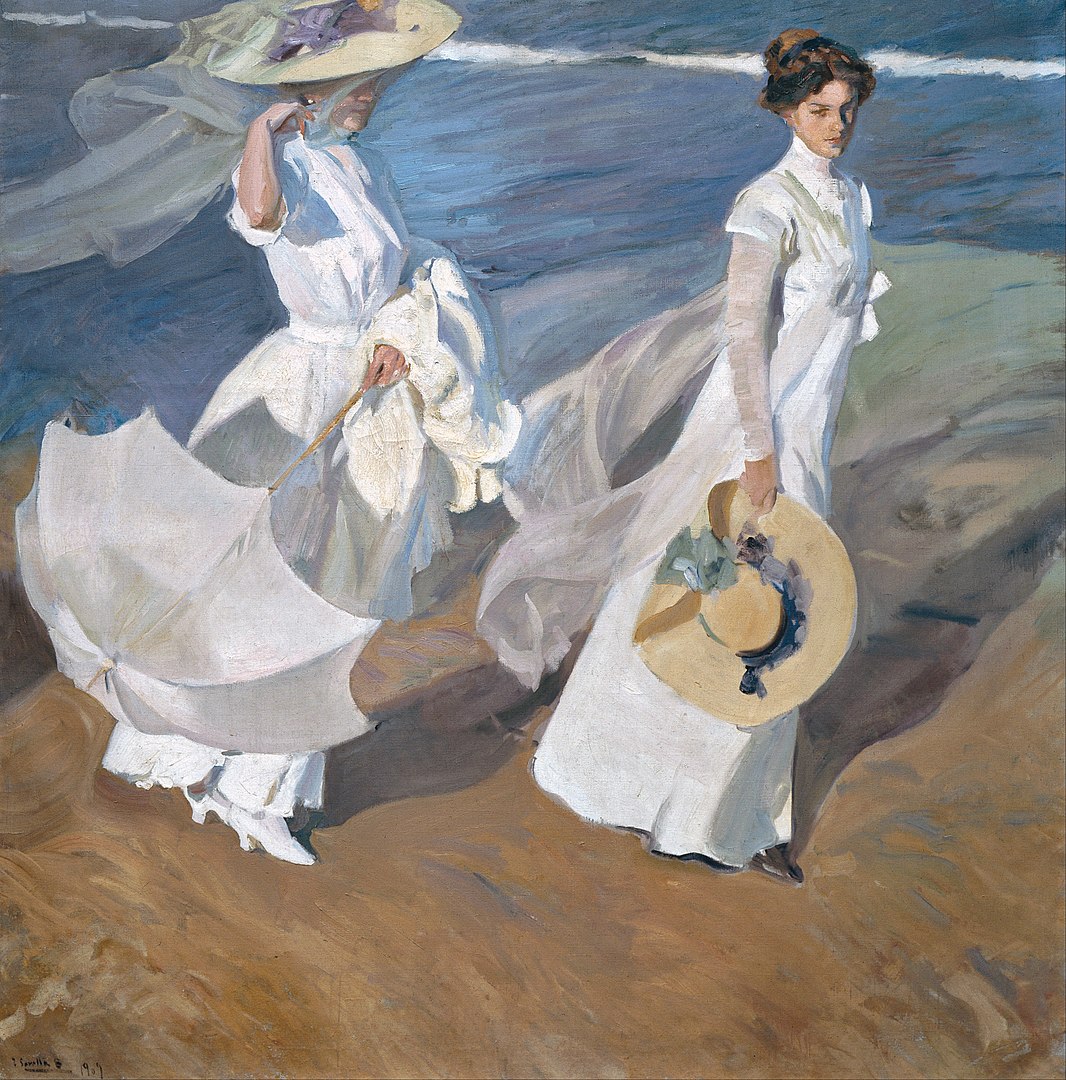
Meaning of Joaquín Sorolla’s “Women Walking on the Beach”
Joaquín Sorolla y Bastida, the celebrated Spanish painter of light and sea, crafted some of the most resplendent and emotionally nuanced works of the late 19th and early 20th centuries. Among his many masterpieces, one painting stands out not merely for its technical brilliance but for its profound human intimacy and symbolic depth, Women Walking on the Beach (Paseo a orillas del mar), painted in 1909. At first glance, it’s a seemingly simple scene: two women, elegantly dressed in flowing white, stroll barefoot along the seashore. But upon deeper inspection, it becomes a poetic visual symphony of light, femininity, movement, and emotion.
This article takes you on an immersive exploration of Women Walking on the Beach, its context, composition, symbolism, and legacy, to understand what Sorolla was communicating through his brushstrokes, and why this painting continues to resonate with audiences over a century later.
The Artist Behind the Light: Joaquín Sorolla
To understand the essence of Women Walking on the Beach, one must first understand the man behind it. Joaquín Sorolla (1863–1923) was born in Valencia, Spain. Orphaned at a young age, he found refuge in art. By his twenties, he had studied extensively in both Spain and Rome, absorbing classical traditions before turning toward naturalism and impressionism. What distinguished Sorolla early on was his obsession with natural light, its textures, reflections, and how it played upon surfaces like water and fabric. He became a master of “luminism,” a term often associated with his technique, which celebrated light as the principal actor in his works.
While Sorolla painted portraits, historical scenes, and social realism pieces, he is best known for his Mediterranean beach scenes. These were not idle genre paintings, but rather deeply personal representations of his environment, family, and emotional states. Nowhere is this more beautifully realized than in Women Walking on the Beach.
The Painting Itself: Who, When, and How It Was Painted
Women Walking on the Beach was painted in 1909 during one of Sorolla’s most prolific and successful periods. At the time, he was traveling back and forth between Spain and the United States. He had just achieved critical acclaim at exhibitions in Paris, London, and New York. This particular painting was created at his beloved summer retreat in Valencia, where the luminous Mediterranean coast provided endless inspiration.
The two women in the painting are Sorolla’s wife, Clotilde García del Castillo, and their eldest daughter, María. Clotilde was a frequent muse and subject in Sorolla’s work, often portrayed with poise, grace, and quiet strength. María, graceful and composed, was already a young woman by then and, like her mother, served as a living symbol of Sorolla’s love and familial devotion.
Using oil on canvas, Sorolla painted Women Walking on the Beach with quick, confident brushstrokes, working en plein air (outdoors), which was typical of his style. He was renowned for capturing scenes directly under the open sky, often racing to keep up with the changing light. He used a large palette, emphasizing whites and blues, to create a vivid interplay between the dresses, the sky, the sea, and the wind.
Composition and What’s Happening in the Painting
The painting captures a tender moment: a mother and daughter walking side by side along the shoreline. They wear flowing white dresses and hold up parasols to shield themselves from the sun. Their feet are bare, touching the wet sand. Behind them, the ocean laps gently onto the beach. There’s a light breeze, evident in the movement of their garments, and a clarity to the midday light that bathes everything in a silvery glow.
What’s happening, literally, is a leisurely stroll. But the composition tells a more profound story. Sorolla places the women to the right of the frame, with the sea stretching behind them and their long shadows reaching across the sand. The elegance of their garments, the natural grace of their steps, and their shared presence create a quiet but powerful sense of harmony. There’s no dramatic gesture, no action, but there is mood, emotion, and storytelling.
The brushwork is loose yet intentional. Sorolla captures the reflections on the water, the dappling light on fabric, and the movement of air. Each detail, though painted rapidly, is precise in its emotional effect.
What the Painting Represents: A Glimpse into Sorolla’s Inner World
Women Walking on the Beach is, in many ways, a visual love letter, to his wife and daughter, to the sea, to life itself. It represents a moment of peace, familial closeness, and feminine grace. The beach, an ever-present motif in Sorolla’s work, becomes a liminal space where time seems suspended, a place of memory, beauty, and simplicity.
This work is also an homage to motherhood and the strength of women. By pairing Clotilde and María, Sorolla links generations, showing not only affection but continuity. Their parasols shield them not just from the sun but from the outside world, emphasizing an inner sanctum of tranquility and love.
Furthermore, this painting reflects Sorolla’s belief in the sanctity of daily life. Unlike the grand history paintings or moralistic social critiques that dominated 19th-century academic art, Sorolla embraced the ephemeral, the beauty of a moment, the radiance of light, the intimacy of family.
Symbolism and Deeper Meaning
At a symbolic level, Women Walking on the Beach is rich with interpretive potential:
1. The Sea as a Metaphor for Life
The ocean, calm yet infinite, is a symbol of life’s ever-changing nature. The women, walking alongside it, are in tune with its rhythm, suggesting harmony between humanity and nature. The sea also hints at the subconscious and the eternal, unspoken emotional depths between the figures and the viewer.
2. White as a Symbol of Purity and Light
The white dresses are not just a fashion choice. In art, white often symbolizes purity, innocence, and transcendence. Here, they reflect and absorb the Mediterranean sunlight, making the figures seem almost ethereal. The use of white emphasizes their otherworldly elegance while also showcasing Sorolla’s technical mastery in depicting nuanced light and shadow.
3. Movement as a Metaphor for Transition
The women are walking forward, not hurriedly, but purposefully. This movement could symbolize the passage of time, the journey through life, or the shifting roles of women in a changing society. By painting them mid-stride, Sorolla captures a dynamic moment of grace in transition.
4. Familial Bond
That the women are related gives the scene an emotional anchor. Their proximity and mutual gesture, one leading, the other slightly behind, evoke maternal guidance and filial respect. It’s a tableau of tenderness, showing not only physical closeness but emotional intimacy.
What Kind of Art is It?
Women Walking on the Beach is most often classified as luminist impressionism, a subgenre of impressionism that emphasizes light and atmosphere over strict realism. Unlike French Impressionists, who sometimes leaned into abstraction, Sorolla retained strong forms and contours. He painted quickly to capture the fleeting quality of light, much like Monet or Renoir, but with a Mediterranean palette and more emotional directness.
Sorolla’s work also borders on naturalism, in that he sought to depict the world truthfully, without romantic idealization, yet still with sensitivity. His subjects are not idealized archetypes, but real people engaged in real life. His technique is painterly, favoring brushwork and color over line and detail.
Current Location
Today, Women Walking on the Beach is housed in the Museo Sorolla (Sorolla Museum) in Madrid, Spain. This museum is located in the artist’s former home and studio, lovingly preserved by his family. The museum not only contains many of his best-known works but offers an intimate look into the life of the artist himself.
Women Walking on the Beach remains one of the museum’s most iconic pieces, often serving as a gateway into Sorolla’s broader body of work. It is universally admired for its emotional depth, technical precision, and its ability to transport viewers into a moment of serene beauty.
A Timeless Celebration of Light and Love
Women Walking on the Beach is not just a painting, it is a quiet celebration of life, family, and the enduring beauty of the everyday. It encapsulates everything that made Joaquín Sorolla one of the great painters of his time: his reverence for light, his mastery of movement, his emotional honesty, and his profound connection to the people and places he loved.
As you stand before this painting, whether in the Museo Sorolla or through a digital reproduction, you are invited not only to admire its surface beauty but to feel the salt air, hear the lapping waves, and walk alongside Clotilde and María in a moment suspended in time. The painting becomes a meditation on presence, memory, and the subtle grace found in ordinary days.
In a world that often celebrates the loud and dramatic, Sorolla reminds us that profound beauty can be found in the quietest gestures, a walk by the sea, a mother’s glance, a daughter’s step, and the eternal dance of light on water.




